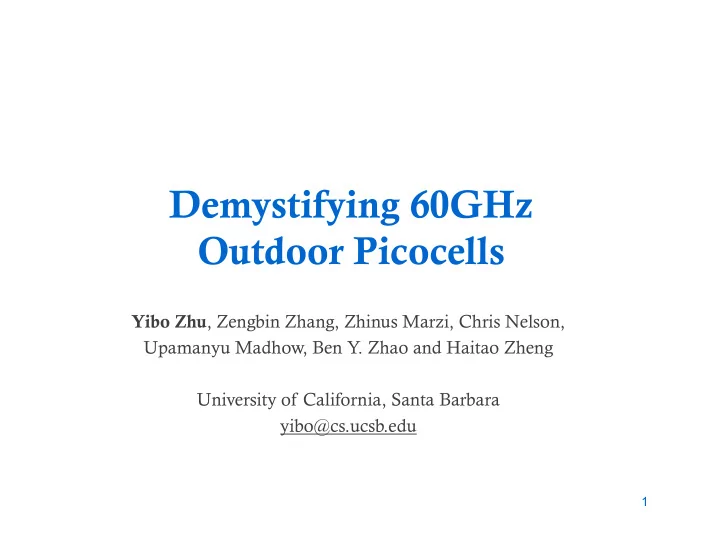

Demystifying 60GHz Outdoor Picocells Yibo Zhu , Zengbin Zhang, Zhinus Marzi, Chris Nelson, Upamanyu Madhow, Ben Y. Zhao and Haitao Zheng University of California, Santa Barbara yibo@cs.ucsb.edu 1
Cellular Network Capacity Crisis • By 2020, bandwidth requirements are predicted to increase by 1000-fold. 1000x Today 100x data 10 MB/day 10x subscribers usage per user • Industry is aware 2
Current Solutions Are Limited • To meet the 1000x requirement, we could.. – Buy more spectrum: (LTE) 100MHz à 100GHz – Massively large MIMO arrays: 1000-element array • In reality, hopefully 2x licensed spectrum and 20x gain from MIMO by 2020 – Still far from 1000x • Need dramatically different approaches to speed up! 3
The Promise of 60GHz • Large unlicensed spectrum available. – E.g. 7GHz unlicensed spectrum Rails for free • Compressed arrays create highly Single element directional beams 2.4GHz antenna 5cm ¡ – Narrow beams minimize interference • Leverage 802.11ad as a great start-point – 802.11ad: IEEE indoor 60GHz standard 60GHz 32-element – Support three channels , up to 6.76Gbps Array 1 , 1.8cm × 0.8cm data rate per channel 4 1 Beyond 802.11ad – Ultra High Capacity and Throughput WLAN, IEEE 11-13/0408r0
If We Could Bring 60GHz to Outdoor LTE 60GHz 10x10 array 60GHz basestation 60GHz basestation LTE macrocell Picocell Picocell Vision: A potential 60GHz picocell architecture • One array for one user, e.g. transmit @2Gbps • A picocell: 4 faces, each face 36 arrays à 288Gbps downlink! • Each face is only 15cm × 15cm large • Narrow beamforming à minimal inter-picocell interference à capacity scales with picocell density 5
Real Life Examples Lamppost-based deployment easily covers downtown streets and intersections. 6
Real Life Examples (cont.) Lamppost-based deployment also easily covers plazas. 7
60GHz Picocell Pros Many arrays transmit simultaneously à ~288Gbps capacity per basestation Spectral Efficiency Very narrow beam à Small interference à Dense cells (every 20m) Amount of Spectrum Cell Density 7GHz unlicensed spectrum à Up to 6.76Gbps link rate Dimensions of Capacity 8
Cons (Common Concerns) • 60GHz oxygen absorption à range too small • High frequency à sensitive to blockage • Narrow beam à user motion breaks connection We perform detail measurements to understand all these concerns. 9
Outline • Motivation • Measurements for demystifying 60GHz picocells – Controlled environment measurements o Range o Blockage o Motion o Spatial reuse – Real-life scenarios measurements • Large-scale simulation • Conclusion & future directions 10
Measurement Methodology • Two testbeds – Wilocity: 802.11ad, 2x8 arrays – HXI: horn antenna o Emulate the main beam of 10x10 arrays Wilocity HXI emulate 2x8 today 10x10 future • Both controlled and real-life environment Basestation Client Real-life environment 11
Range • Concern: 60GHz range too small for outdoor Minimum ¡Link ¡Rate ¡(Mbps) ¡ Radio ¡Type ¡ Weather ¡ 385 ¡ 1155 ¡ 2310 ¡ Clear ¡ 23m ¡ 23m ¡ 15m ¡ 10m ¡ Wilocity ¡2x8 ¡ EIRP=23dBm ¡ Heavy ¡rain ¡ 22m ¡ 22m ¡ -‑ ¡ -‑ ¡ Clear ¡ 178m ¡ 124m ¡ 124m ¡ 93m ¡ HXI ¡10x10 ¡ EIRP=40dBm 1 ¡ Heavy ¡rain ¡ 139m ¡ 102m ¡ 102m ¡ 79m ¡ Range measurement results • Wilocity small array + low power à ~20m • Larger array + higher power à 1Gbps at >100m – Align with theoretical link budget calculation 1 40dBm EIRP is under FCC regulation. 12
Robustness to Blockage • Concern 2: pedestrians easily block the signal 6m Impact region <5m 2 • Blockage impact region is small (<5m 2 ) – The peer must be close enough to block – Higher basestation à smaller impact region 13
Handling Blockage via Reflection • We can use NLoS path when LoS is blocked • Most outdoor materials have <5dB reflection loss – Metal, plastic, wood, bricks, etc LoS Blocked, LoS unblocked, switch to NLoS switch to LoS <5dB loss Wilocity chipsets handle blockage via reflection. 14
User Motion • Concern 3: user motion breaks 60GHz connection Realign Realign beam to adapt user motion • Realign the beam every ~2s maintains >50% throughput in worst cases (details in paper) – Wilocity realign fast enough – Longer distance even easier 15
Interference and Spatial Reuse • What is the minimal basestation separation for low interference? – “Worst-case” scenario: two collocated users Separation • 10x10 arrays à ~20m separation is enough • Transmission range 100m >> 20m separation à high spatial reuse – Picocells can largely overlap 16
Real-life TCP Performance • 10 locations w/ random pedestrians BS Shopping Mall Campus Plaza Clients Client BS Link broke due to blockage w/ wall reflection, rate from crowds of pedestrians fluctuated but didn’t break often 3000 3000 Data Rate Data Rate 2500 2500 TCP Throughput TCP Throughput 2000 2000 Mbps Mbps 1500 1500 1000 1000 500 500 0 0 0 1 2 3 4 5 6 7 8 9 0 10 20 30 40 50 Time (minute) Time (minute) 17
Real-life Performance (cont.) • Test two basestations simultaneously – Dense deployment à multiple basestations in range BS1 ¡ Clients ¡ BS2 ¡ BS #1 BS #1 Link Uptime (%) Link Uptime (%) BS #2 BS #2 Switching 100 100 75 75 50 50 25 25 0 0 1 1 2 2 3 3 4 4 5 5 6 6 7 7 8 8 9 9 10 10 Client Location Client Location • Switching between two basestations à nearly 100% availability! We need a pico-cloud architecture that serves each 18 user with multiple basestations.
Large-scale Simulation • Examine street locations every m 2 Simulated NYC Street • Buildings & trees from Google Map • Pedestrians & cars from surveys • Availability: two basestations à nearly 100% – Confirm the real-life measurement • Interference: 20m basestation separation à minimal throughput loss 19
Conclusion & Future Directions • Propose 60GHz outdoor picocell • Measurement verifies the feasibility and potential • Future research directions – Pico-cloud architecture – User tracking – Cross-layer protocol design – Hardware design o Energy efficient arrays 20
Recommend
More recommend